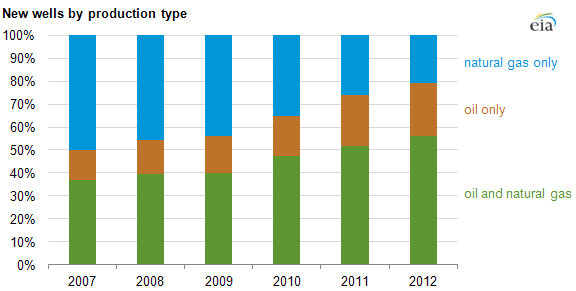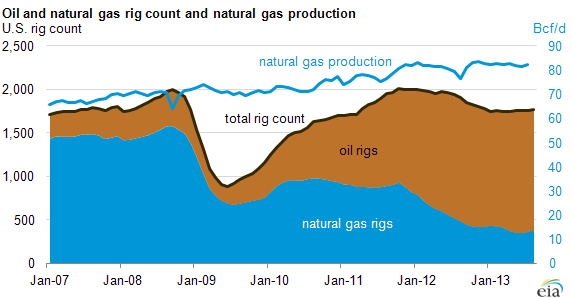
Posted on 10/30/2013 10:52:19 AM PDT by ckilmer
October 28, 2013

Republished October 28, 2013, 3:45 p.m., text was modified to clarify content.
In the past, the number of gas-oriented drilling rigs in a particular region has been a common metric for estimating the production of natural gas. However, technological advances have led the way to the widespread use of new oil and natural gas extraction techniques that have opened up a hydrocarbon resource base dramatically larger than previous estimates. Because of these new methods of extraction, generally in wide use since 2007, natural gas production has steadily risen, while the number of active rigs characterized as targeting natural gas has fallen dramatically.
The number of wells drilled nationwide that have produced both oil and natural gas increased from 37% in 2007 to 56% in 2012 (see chart below). This increase helps explain why natural gas production can rise (as it has) even as the number of rigs characterized as drilling for natural gas has fallen. 
Using historical data (starting from 2007, corresponding to large-scale adoption of horizontal drilling and multistage hydraulic fracturing by industry), EIA developed a process model to estimate production trends and volumes in six major shale plays, which is one part of EIA's monthly drilling productivity report (DPR).
The DPR combines rig count data with well production data to calculate variables such as:
The DPR also includes a forecast of production through the month following the report release.
To estimate production for the most recent months, DPR uses the total observable rig count, along with recent trends in the key relationships between drilling and production. Using the expected productivity from all drilling rigs to estimate the oil and gas production coming from all resultant wells improves upon simple rig count models. Specifically, it does not break drilling into categories based on drilling targets (oil or gas), well type (vertical, directional, horizontal), or operator. The most relevant information for the DPR comes from the total number of rigs drilling, where those rigs are drilling, and the average efficiency and productivity of those regions.
Tomorrow's Today in Energy article will focus on the importance of reporting oil and natural gas activity together in the DPR.
Principal contributors: Jozef Lieskovsky, Sam Gorgen
ping
Eat Chili, Get Gas...
We are absolutely awash in crude. Price should be $2.50 per gallon, tops. Refiners have so much crude and capacity now that they are going to crank up production and sell finished fuels to other countries.
Not only crude, but natural gas as well. Same story, different product.
In addition to increased productivity per well, we have far greater cost, much more footage drilled per well, more acreage coverage per well and steeper decline rates per well.
The same source (EIA) has started producing a Drilling Productivity Report.
http://www.eia.gov/petroleum/drilling/pdf/dpr-full.pdf
The attached charts not only show a greater initial production rate for the new tight formations like shale, they also show the drop off rate is growing faster as more horizontal tight-formation wells make up a higher percentage of our total number of producing wells.
No doubt the industry is changing. It dang sure has gotten busy in the US. Trying to find additional staff in these fields is still climbing in cost.
But the cost of gasoline and diesel have little to do with the refining cost and mostly the cost of crude. Refining is a low margin business.


No doubt the industry is changing. It dang sure has gotten busy in the US.
....................
agree
Trying to find additional staff in these fields is still climbing in cost.
..........
judging by the hints you see about underground peering technology and the software that makes sense of the stuff—combined with the collapsing failure rate....I’m inclined to think the cost of finding new oil is falling. However, finding staff would be a problem. I’d love to do the work myself but I turned 60 this year and have no background in the field. About the best I can say is that I do have a pulse. I’m surprised the drillers just don’t go to Texas A&M and just hire any the students there as don’t care to study for roughneck work—and then just corral entire graduating classes.
This should not come as a surprise to anyone. There are two major reasons for climbing natural gas production even though the number of “gas” drilling rigs is declining:
1) Publicly traded exploration and production companies want to be able to report to investment analysts that they are drilling for oil (higher margins), and not gas (lower margins), so they label their permit applications as oil or liquid wells rather than gas wells, even though most of the production ends up being gas.
2) In resource plays, every oil well also produces associated gas. To make hundreds of barrels of oil a day, a well will also produce several million cubic feet of gas per day, which must either be flared or sold. Since air permitting and other regulations restrict the amount that can be flared, more and more of this oil well gas (”casinghead gas”) is produced and sold. Hence with climbing oil production, gas production will also increase.
We are not “awash in crude” on a global basis. All domestic crude oil production is just another piece of global supply, and to the extent that it is utilized in the U.S., it displaces another barrel of imported crude, but it will still be priced at a global price point. Natural gas is a different matter. North America is a closed system until LNG export plants come on line, so the abundance of gas has clearly depressed prices.
It is past time for natural gas cars to become mainstream.
I don't think that is true. If I find some numbers I'll post them. Usually oil companies don't measure "finding" cost but rather "replacement" cost.
For each barrel they pump out, they need to find another barrel and put it in the proved reserve by flow testing a well. If they don't replace each barrel in their reserves, they are not in the oil business, they are going out of the oil business.
If I find the changes in replacement oil cost, I'll get the link.
I’m surprised the drillers just don’t go to Texas A&M and just hire any the students there as don’t care to study for roughneck work—and then just corral entire graduating classes.
You know those oil companies pay a whole lot more money to the engineers that graduate, rather than drop out and sling chain and carry tools.
EXXONMOBIL 2012 FINANCIAL & OPERATING REVIEW
http://www.exxonmobil.com/Corporate/Files/news_pub_fo_2012.pdf
Proved reserves replacement costs (dollars per barrel)
2012 16.47
2011 16.31
2010 20.28
2009 14.45
2008 8.29
- - - - - - -
2009 Financial and Operating Review
http://media.corporate-ir.net/media_files/irol/11/115024/XOM_2009F&O.pdf
2009 10.83
2008 10.76
2007 6.50
2006 7.00
2005 6.25
- - - - -
I don’t know why 2009, 2008 numbers don’t match in the reports. Maybe they changed the way it is calculated or what it includes.
But I think the trend is up, not down for cost.
For each barrel they pump out, they need to find another barrel and put it in the proved reserve by flow testing a well. If they don’t replace each barrel in their reserves, they are not in the oil business, they are going out of the oil business.
...........
wasn’t it you who posted that the woodford cana shale formation was projected to have 50 billion barrels of addressable oil. the company that made the projection was one of the early baaken companies that called the high numbers in the baaken correctly.
i think I’ve read that the trend is up for the majors but down for the minors.
the shale oil play is mostly a small to midsize oil company play.
You would have to show me that. Maybe if they were paying too much before.
the shale oil play is mostly a small to midsize oil company play.
It may have started that way, but the majors are buying in. They are more into risk management. We are getting past that now.
I hope not. Woodford is basically a Natural Gas, not Oil, Play.
Arkoma Woodford was more of a Dry Gas field and Cana Woodford is gas with Natural Gas Liquids (NGL) like ethane, propane, butane.
Targeting Oklahoma’s Ubiquitous Woodford Shale
http://www.ugcenter.com/Woodford/Targeting-Oklahomas-Ubiquitous-Woodford-Shale_118127
June 27, 2013
Is it possible you are thinking about the article you posted recently about South Central Oklahoma Oil Province (SCOOP) that is an area southeast of the Cana play?
In that thread we discussed why talking about oil in place is far different that technically and economically producible oil.
http://www.freerepublic.com/focus/f-news/3082214/posts
In that thread we discussed why talking about oil in place is far different that technically and economically producible oil.
http://www.freerepublic.com/focus/f-news/3082214/posts
.....................
Continental Resources, the leading shale oil producer in the Williston Basin beneath North Dakota and Montana, revealed last year its next big target for development is an area southeast of the Cana play it has dubbed the South Central Oklahoma Oil Province (SCOOP).
SCOOP is a world-class resource, according to the company, with an oil-rich shale formation up to 400 feet (122 metres) thick. Continental estimates SCOOP contains up to 70 billion barrels of oil-— in place-—(my emphasis)
..............
In the same way the baaken has 400 billion barrels in place but only about 15 billion barrels are recoverable.
i think I’ve read that the trend is up for the majors but down for the minors.
You would have to show me that. Maybe if they were paying too much before.
,,,,,,,,,,,,,,,,,
here is anecdotal evidence.
http://www.reuters.com/article/2013/10/18/shale-usa-idUSL6N0I819G20131018
Continental has one of the most successful track records in the shale business.
The company has pioneered a highly efficient, assembly-line approach to drilling and fracturing in the Bakken formation that cut costs and raised production quickly. It claims to be able to achieve rates of return of over 20 percent on a typical shale well with prices as low as $60 per barrel.
If Continental can bring the same approach to SCOOP, the state’s oil and liquids output is set to rise rapidly.
That is discussing production costs, not replacement reserve cost.
Disclaimer: Opinions posted on Free Republic are those of the individual posters and do not necessarily represent the opinion of Free Republic or its management. All materials posted herein are protected by copyright law and the exemption for fair use of copyrighted works.